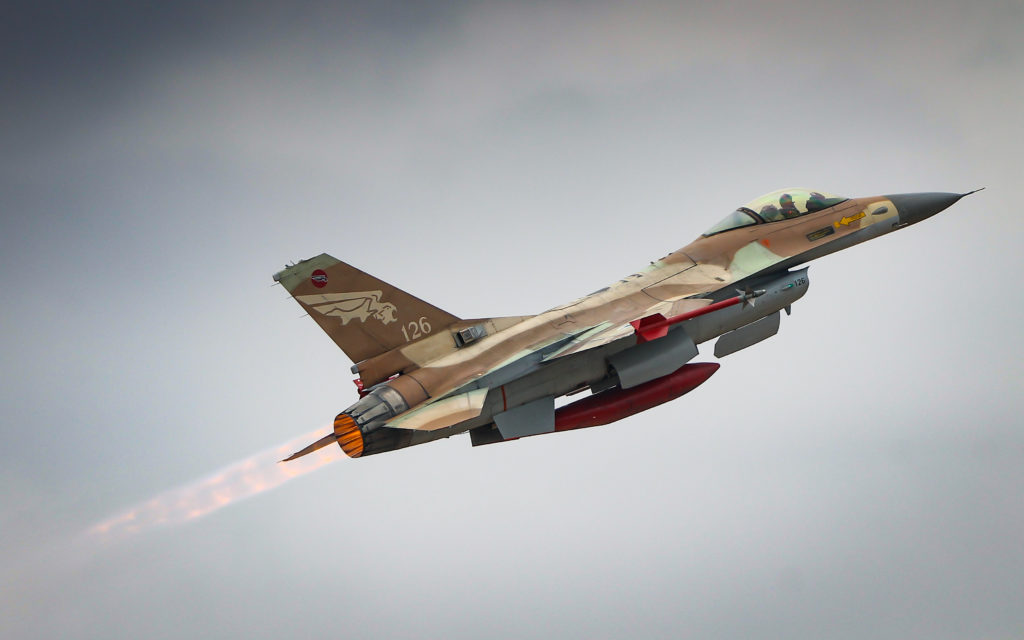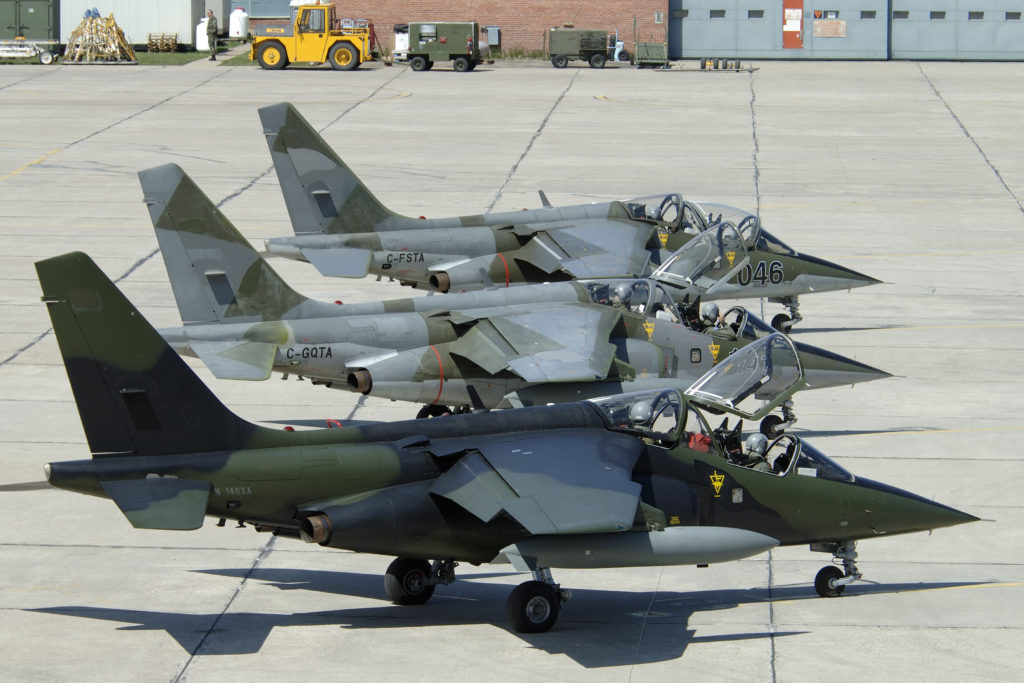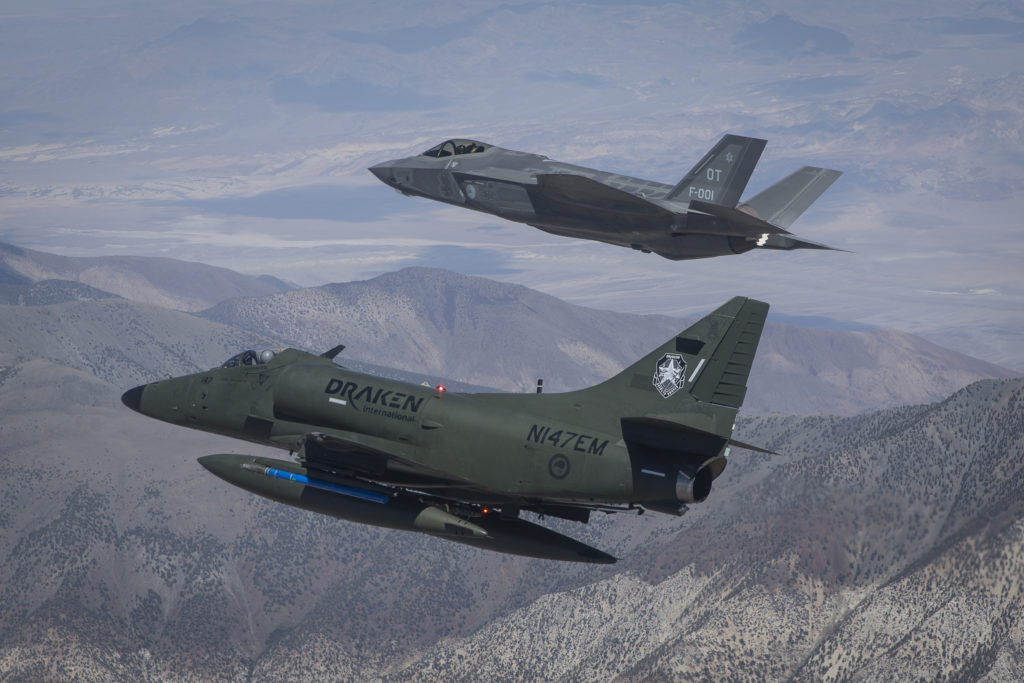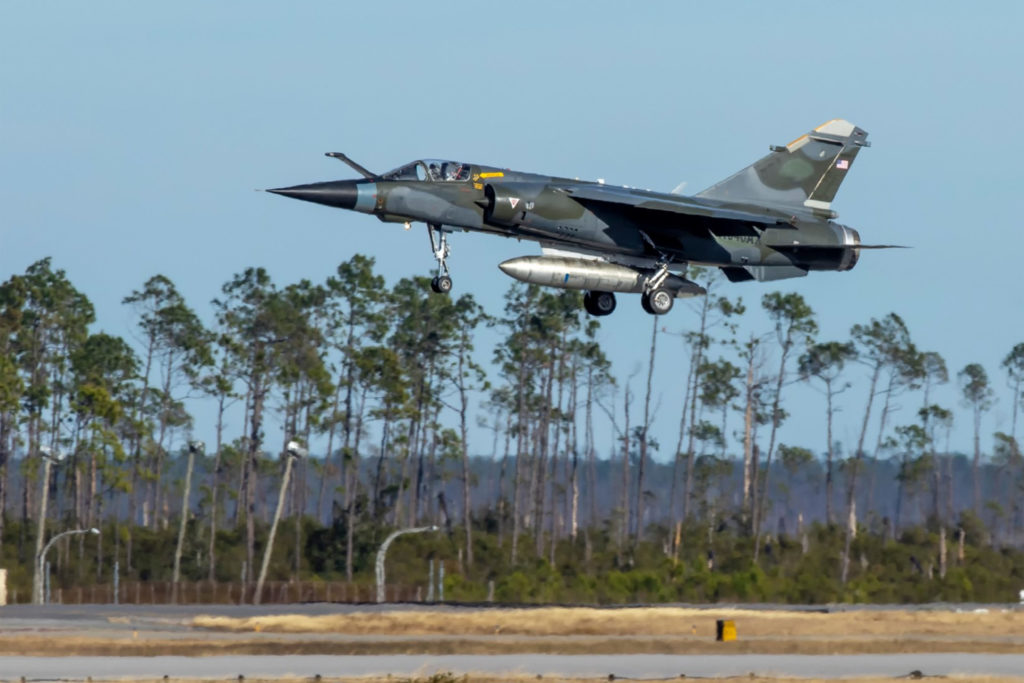Estimated reading time 26 minutes, 20 seconds.
Canadian-headquartered contract air service provider Top Aces took delivery of the first of its long-planned fleet of F-16 Fighting Falcons this week. Four former-Israeli Air Force F-16A/Bs, known as Netz (Hawk), were loaded aboard a giant Antonov An-124 transport aircraft at Ben Gurion Airport on Jan. 27, 2021, bound for Top Aces’ new F-16 Center of Excellence at Phoenix-Mesa Gateway Airport, Arizona, where they arrived the following day.

The three stripped-down F-16As and one F-16B in the first shipment to Top Aces were among the first examples delivered to Israel under the Peace Marble I defense deal in 1980. Two of these actual jets are “MiG-killers” from campaigns against Syria. Having attached its last examples of the Netz to aggressor duties in their later years of service, Israel retired these early F-16A/Bs from 2014 and put them up for sale in late 2016. Israel retains its newer and more advanced F-16C/Ds and F-16Is.
Top Aces has openly advertised long-held plans to upgrade its existing fleet of contract air support aircraft with secondhand F-16s since 2014. In December 2019, the company announced that Russ Quinn had been appointed as president of the Top Aces Corporation — which is based in Mesa, and is a subsidiary of Top Aces Inc. in Canada. In a news release Top Aces said, “Quinn has been instrumental in overseeing domestic and international growth while simultaneously leading the stand-up of the U.S. F-16 Center of Excellence specifically designed to serve U.S. Department of Defense adversary air needs.”
Quinn flew F-16s with the U.S. Air Force, and Top Aces’ CEO, Paul Bouchard, stated: “With his unique background in F-16 tactical aviation, executive leadership, and business development, Russ is the perfect candidate to lead our expanding U.S. operations. We are extremely well positioned for growth in the United States with our unique 4th-generation open system architecture offering.”
The need for aggressors
The concept of aggressor aircraft, also known as “Red Air,” is to present enemy aircraft tactics and performance characteristics to regular squadron pilots. It essentially stems from the U.S. Air Force Red Baron Report and the U.S. Navy’s Ault Report, both of which came in the wake of the Vietnam War when American fighter pilots’ “kill” ratios plummeted against enemy MiGs. Among a range of factors, it was found that aircrews spent too much time “fighting” their squadron mates in identical types, and that they lacked the requisite training to tackle dissimilar fighter aircraft types.

The finding led directly to the establishment of fighter weapons schools, with the Navy forming TOPGUN, and the USAF starting Exercise Red Flag — both of which were essentially designed to help aircrews learn how to survive their first few combat missions of a war. The U.S. military set about detailed analysis of enemy capabilities and tactics through Foreign Military Exploitation — evaluating actual enemy MiGs — and standing up specialist aggressor squadrons, designed to give squadron aircrews a thorough grounding in how best to tackle an adversary in aerial combat.
The number of aggressor squadrons in the U.S. military ebbed and flowed over the years. The U.S. Navy shuttered most of its so-called adversary squadrons in the mid-1990s, and the role mainly passed across to its reserve forces, as well as at TOPGUN. After an initial surge, the end of the Cold War brought about a dramatic reduction in the volume of aggressor units within the USAF. However, by the late 2000s, the USAF had three dedicated units — two with F-16C/D Fighting Falcons and one with F-15C/D Eagles. This reflected a need to provide adequate professional aggressors to properly stress the USAF’s emerging fleet of very capable modern fighters, such as the F-22 Raptor.
In 2014, budgetary pressures led to the closure of the USAF’s F-15C/D aggressor squadron at Nellis Air Force Base, Nevada. Ironically, this coincided with the ramp-up of 5th generation assets within the USAF’s ranks, which required increasing levels of opposing aggressor forces to properly tax their impressive capabilities.
As set out in the Red Baron report, “in-house” squadron air-to-air training, which means generating their own Red Air assets to represent opposition forces, fails to provide adequate learning objectives. Moreover, in an era of expensive fighter aircraft, it presents a level of unnecessary wear and tear on expensive-to-operate and maintain fighters. Therefore, the USAF sought more cost-effective solutions to meet its regular air-to-air training needs.
Bad guys on demand
Contract Air Support is not a new concept in the U.S. The Airborne Tactical Advantage Company (ATAC) secured U.S. Navy contracts for adversary support from 1994 amid a lack of in-house adversary units. It has supported training squadrons and fleet readiness exercises by offering cost-effective Red Air, while also flying attack profiles against surface vessels to train operators in self-defense. ATAC primarily utilized a fleet of aging Israel Aircraft Industries F-21 Kfirs and Hawker Hunters to maintain a low cost base, while employing experienced aviators who could offer insight and expertise to maximize the value of the company’s offering.

Meanwhile, Top Aces was formed in 2000 by a group of experienced former air force fighter pilots to provide adversary, air defense and Joint Terminal Attack Controller (JTAC) training services. It followed the mantra of enabling “operational readiness of combat forces by providing realistic real-world experience while prolonging its customers’ fleet life.” Essentially, presenting an adequate opponent for training and eliminating the need for squadron pilots and jets to be allocated to these roles. In Canada, Top Aces began offering electronic warfare and adversary support to the Department of National Defence (DND) with a fleet of ex-Luftwaffe Alpha Jet training aircraft.
The Royal Canadian Air Force (RCAF) launched its Contracted Airborne Training Services (CATS) program in 2005 under an agreement with Top Aces. The company subsequently procured Advanced Training Systems International (ATSI), which operated former-Israeli A-4 Skyhawks out of Williams Gateway Airport (now Phoenix-Mesa Gateway Airport), in Arizona, as contract air support assets. Top Aces went on to win target-towing and Red Air contracts in Germany using its acquired Skyhawks.
In October 2017, under its relatively short-lived Discovery Air Defence Services identity, Top Aces retained the RCAF’s CATS program with a 10-year deal worth about $480 million, which includes options to extend the service to 2031 and the value to as much as $1.4 billion.

Meanwhile, Draken International was formed in 2011 by entrepreneur Jared Isaacman, who pounced on an opportunity to procure the Royal New Zealand Air Force’s (RNZAF’s) fleet of redundant Aermacchi MB339s and A/TA-4K Skyhawks. Issacman established an L-39 display team, but also started to evaluate the contractor aggressor requirement. While the U.S. Navy had embraced contract air support with ATAC, the USAF hadn’t followed suit. That was until it lost its F-15 aggressors at Nellis.
To address the major shortfall in aggressor assets at Nellis, the USAF released a proof-of-concept tender, which led to the year-long Adversary Air (ADAIR) I pathfinder experiment at the Nevada base from 2015. Draken International was selected to support both the resident USAF Weapons School as well as exercises such as Red Flag, working in concert with the resident 64th AGRS F-16C/Ds. Draken initially provided its radar-equipped Skyhawks, which were later joined by Aero L-159 ‘Honey Badger’ Advanced Light Combat Aircraft (ALCA) to provide adversary support at dramatically lower costs than a comparable military fighter.
Draken gained something of a foothold thanks to the Nellis experiment, expanding its offering to support other taskings such as Royal Netherlands Air Force F-35A operational testing out of Edwards AFB, California, and JTAC training at NAS Fallon, Nevada. In June 2017, the USAF awarded Draken a follow-on, five-year, $280-million ADAIR II contract. Only two bidders came forward for ADAIR II, which Draken secured as a three-year contract with two option years — out to December 2023. The contract specified that Draken’s ADAIR II aircraft must be capable of flying at Mach 1.5 and of completing sorties of up to 60 minutes duration. As soon as Draken signed the contract it was obliged to execute at least 22 missions per day within the first month of operations. Few other companies could have achieved such an aggressive requirement at that time.
The big prize
While the USAF’s two F-16 aggressor squadrons provide very high-end threat replication, the contractor solutions are geared towards presenting a volume of threats for pilots to deal with. While Draken was engaged in training the USAF Weapons School, it did so under the guidance of the resident 64th Aggressor Squadron, essentially designed to plus-up the threat presentations. The USAF’s Air Combat Command (ACC) was increasingly aware that its operational wings and training units were soaking up precious flight hours acting as bad guys during daily flying.

The Nellis initiative served as the precursor to a huge new plan that emerged under the Combat Air Forces Contracted Air Support (CAF CAS) program. ACC drew up plans to dramatically expand contract aggressors to support units in the Continental USA. The USAF started to work closer with the growing number of contractors in the market, refining its requirements and ensuring it was seeking a realistic solution that could be delivered by the commercial providers. They were permitted to provide support with several aircraft types, with requirements including operations at speeds of between Mach 0.8-1.5, and altitudes up to 50,000 feet. The contracted aircraft had to be compatible with captive air-to-air training missiles and electronic countermeasures pods, infrared search and track (IRST), and around half would require a radar with a range of up to 80 nautical miles (148 kilometers).
As part of CAF CAS, the companies are required to supply contractor-owned, contractor-operated (COCO) aircraft. Some of the companies are concentrating on contracted close air support (CCAS) for JTAC training. Only U.S.-based companies were permitted to bid as prime contractors, and aircraft must be flown by American civilians. However, the aircraft can be sourced from Western nations or from “threat countries.” All of this was deemed to be achievable despite a relatively modest cost per flight hour (CPFH).
ACC announced on Oct. 18, 2019 that it had selected seven companies that could individually bid for the indefinite delivery/indefinite quantity (IDIQ) contract worth up to $6.4 billion to provide adversary air over five years. The seven companies that were downselected for the contracts were Air USA, ATAC, Blue Air Training, Coastal Defense, Draken International, Tactical Air Support (TacAir), and Top Aces.
The approved vendors began bidding against the operational taskings laid out initially at 12 locations for the air-to-air adversary requirement, and nine locations for JTAC training. According to the umbrella contract, the USAF said it was seeking 30,000 adversary sorties and 10,000 CAS training sorties per year. Services were budgeted for Eglin AFB, Florida; Joint Base Hickam-Pearl Harbor, Hawaii; Hill AFB, Utah; Holloman AFB, New Mexico; Kelly Field, Texas; Kingsley Field, Oregon; Joint Base Langley-Eustis, Virginia; Luke AFB, Arizona; Nellis AFB, Nevada; Seymour Johnson AFB, North Carolina; Tucson International Airport, Arizona; and Tyndall AFB, Florida.
The adversary contractors
In anticipation of this huge USAF requirement, the respective companies started to increase their fleets. ATAC procured former French Air Force Mirage F1CR/CT and F1Bs, which began arriving at its new Adversary Center of Excellence (ATAC-ACE) in June 2017. It acquired 63 F1s from France, along with support equipment and 150 engines. Its facility at Fort Worth Alliance Airport, Texas, is where it performs maintenance, repair and overhaul work on the approximately 80 jets operated by the company. It marked the first flight of one of its Mirage F1s at Alliance Airport, Texas, on Aug. 22, 2019, as a two-seat Mirage F1B made an initial acceptance flight. ATAC has steadily returned its F1s to flying status, initially securing a contract to provide chase aircraft for F-35 acceptance flights at Fort Worth, while also addressing the huge USAF requirement.

Meanwhile, TacAir of Reno, Nevada, acquired a fleet of 21 F-5E/Fs from the Royal Jordanian Air Force to complement its existing former Canadian CF-5Ds. The company swiftly developed an upgrade for the ex-Jordanian aircraft, adding a Garmin glass cockpit and low-cost NEMESIS Mechanically Scanned Array (MESA) radar — dubbing the aircraft F-5AT ‘Advanced Tigers.’ TacAir says the beauty of the F-5 is that it has a proven track record in the adversary field, and that there are a number of specific upgrades that can be used to enhance these fighters. The U.S. Navy has decided to adopt the TacAir upgrade for its own fleet of F-5E/Fs, which is now under way.
TacAir’s work was swiftly rewarded when in 2018 it was awarded a five-year $107-million contract through May 2023 from the U.S. Navy to provide adversary air services, in addition to training for air and ship crews to counter electronic threats. The award was challenged by ATAC, which proposed a fleet of ex-Jordanian F-16AMs to meet the requirement. The challenge was denied and the contract went forward, with the Government Accountability Office noting that the advantages of the F-16 were outweighed by the affordability of the F-5…
Draken International, too, started expanding its fleet to meet the new USAF requirement, acquiring former Spanish Air Force Mirage F1Ms, and 12 Denel Cheetahs from South Africa. The Cheetahs offer the EL/L-2032 radar and Elisra Radar Warning Receiver. The first of 22 ex-Spanish Mirages arrived at Draken’s Lakeland, Florida, facility in July 2018, and the first aircraft returned to the air under Draken ownership on Nov. 12, 2019. Since that time, Draken’s Mirage F1s have steadily returned to flight and increased the company’s operational footprint at Nellis AFB. Draken says the aircraft will field a helmet-mounted cueing system, infrared missile seekers, data links, and electronic jamming and Radar Warning Receiver capabilities. On April 3, 2020, Draken announced that it had also started to receive Mirage F1s from the Royal Jordanian Air Force.
Air USA also announced plans to expand, acquiring up to 46 former Royal Australian Air Force F/A-18A/B Hornets in March 2020 as part of its plans to bid for the USAF contracts.

In July 2020, ACC announced the winners of the first five locations to receive contract air support under CAF CAS. ATAC secured contracts at Holloman and Luke AFBs. ATAC’s two awards were worth $113.9 million at Holloman and $126.6 million at Luke, and designed to provide air-to-air adversary training for new pilots going through the respective F-16 and F-35 Formal Training Units (FTUs) at these bases. The combined awards called for just over 3,000 sorties per year for up to 4.5 years.
Draken was selected to cover F-15E Strike Eagle training at Seymour Johnson AFB in a deal worth $74.5 million for 1,000 annual sorties, and F-16 training at Kelly Field under a $28.2-million agreement for 530 annual missions. TacAir won the contract for Kingsley Field in Oregon to provide 800 annual sorties with its F-5ATs at the F-15C FTU under a contract worth $90.4 million. It was subsequently announced that ATAC had also secured the contract for support at Eglin AFB.
Meanwhile, the USAF is concurrently expanding its own aggressor forces, reactivating the 65th Aggressor Squadron at Nellis to fly additional F-16C/Ds, as well as the first aggressor-assigned F-35A Lightning IIs. The squadron is reforming this year and the first aggressor F-35s are expected to commence operations in the summer.
Top Aces positions for U.S. requirement
Top Aces repeatedly asserted that it would acquire F-16s, despite the expected operating costs that these aircraft incur compared with other offerings in the market. In December 2020, Skies reported that Top Aces had received approval to acquire and import 29 F-16s from an undisclosed country. It said the aircraft would be upgraded and offered as a platform to support CAF CAS beginning in 2021.
Upon its inclusion in the over-arching CAF CAS contract, Top Aces said: “This contract provides a vehicle through which Top Aces can offer it’s highly advanced adversary air capabilities and compete for individual tenders at 12 USAF bases. Top Aces Corp. will be the first provider to offer the F-16 platform, configured with a unique open system architecture designed to meet the diverse needs of the USAF customer.”
On Jan. 27, 2021, Top Aces said its “first batch of F-16s are currently on their way to Mesa in support of the U.S. DoD adversary air training.” This coincided with the reports from Israel that four F-16 Netz had been loaded and shipped. The aircraft arrived at Mesa on Jan. 28, and Top Aces said in a statement: “Top Aces is the first commercial provider in the world to offer the supersonic F- 16. The upgraded fleet of F-16s are able to employ an Active Electronically Scanned Array (AESA) radar, helmet-mounted cueing system, tactical datalink, and high off boresight missile capability to provide unparalleled adversary air training.”

“Our vision is to be the most trusted provider of innovative combat training solutions in a highly specialized industry where experience matters,” said Russ Quinn. “We acquired our fleet of F-16s in order to fulfill our vision of training the next generation of combat leaders here in the U.S.”
With the first four aircraft now at Mesa, Top Aces will likely reassemble and prepare these aircraft with the necessary equipment to be ready as soon as possible to meet the next round of bidding for the USAF’s CAF CAS requirement. The interoperability of its F-16s with existing USAF types is likely to be a major advantage, and they will offer a good baseline capability. Overall, the mix of good sensors and strong aerodynamic performance will give Top Aces a potent offering, especially if it can keep costs in line with what the competition is offering.








